New Hampshire, might be landlocked, but it is home to some of the cleanest and clearest freshwater bodies in the USA. The cold waters in this small state, tucked away near the Canadian border, are a haven for many massive fish. In this article, we will discuss 18 of the largest fish caught in New Hampshire, from the massive northern pike to the amazing rainbow trout! Let’s dive in!
Editor’s Note: The photographs in this article do not picture the individual specimens that are covered.
1. Northern Pike — 26 Pounds, 44.5 Inches
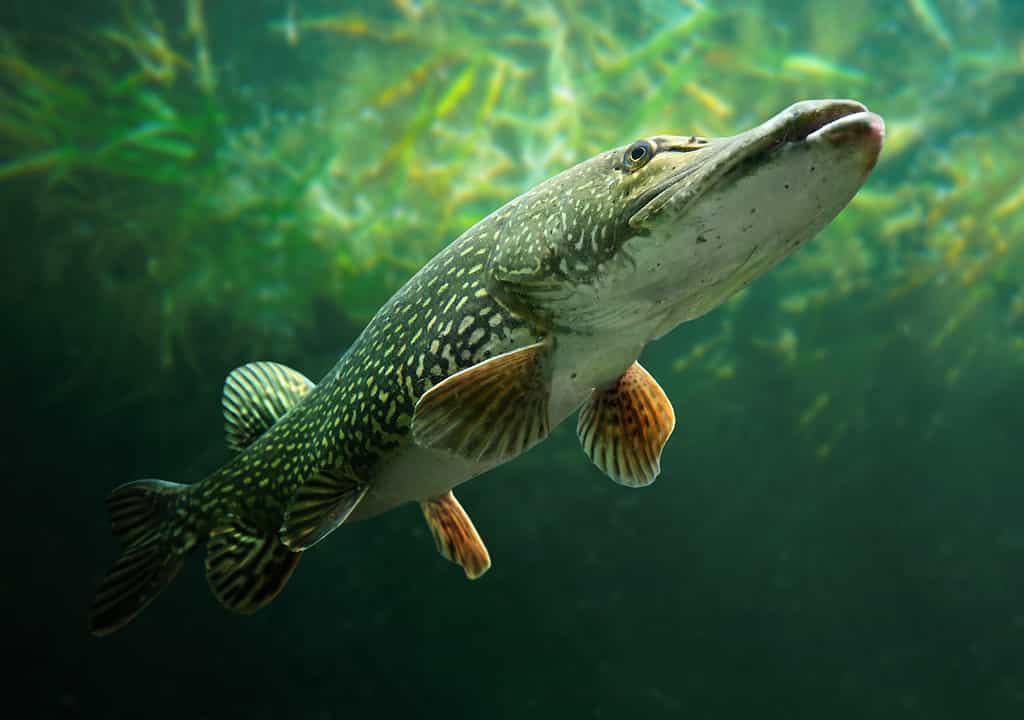
The longest fish ever caught in New Hampshire was a northern pike in 2013.
©iStock.com/abadonian
The northern pike is an olive-green, carnivorous fish native to North America and Northern Eurasia. These fish have white bellies and unique side markings. While they usually grow between 15 to 22 inches long, they can sometimes be much bigger, stretching to a whopping 59 inches! They love living in freshwater lakes and rivers, specifically, hiding sneakily in weed beds, ready to ambush their prey. Their favorite meals? Mostly smaller fish, but occasionally, they’ll chow down on amphibians or even small mammals.
On February 16, 2013, a man named Kevin Phelps caught the biggest northern pike in New Hampshire. It was at Moore Reservoir in Dalton, and this monstrous fish weighed an impressive 26 pounds 9.44 ounces, and it was 44.5 inches long! This northern pike also turned out to be the longest fish ever caught in the state.
2. Lake Trout — 37 Pounds, 42.125 Inches
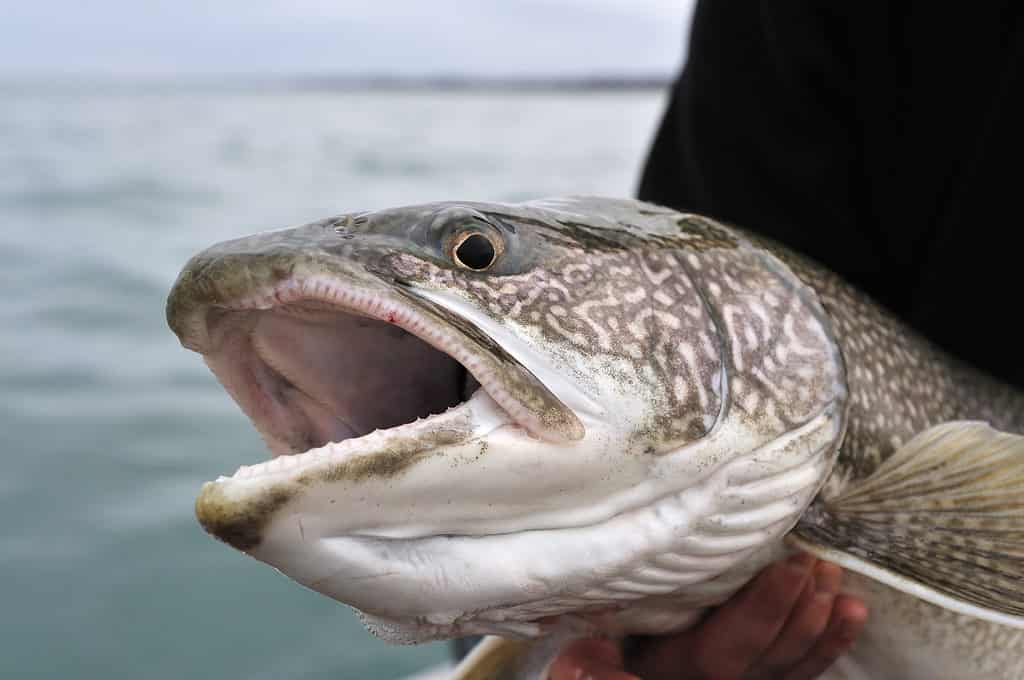
The largest trout species in the USA are lake trout, growing to over 50 pounds in some cases!
©iStock.com/glxedwards
Lake trout thrive in oxygen-rich lakes and thrive in the cold, clean waters of New Hampshire. These are large fish that you can commonly find in Canada, Alaska, the Great Lakes, New England, and parts of the Rocky Mountains. These greenish-gray fish, decorated with pale yellow to white spots, usually grow to 17 to 27 inches. However, occasionally, they can reach an astonishing 50 inches! They naturally favor the deeper, colder parts of lakes, usually swimming around 60 to 200 feet deep. Being top predators, they mostly eat other fish.
On February 25, 2020, Thomas Knight caught a massive lake trout in New Hampshire’s Big Diamond Pond in Stewartstown. This giant fish weighed 37 pounds 10.4 ounces and measured 42.125 inches, proving lake trout can grow really big in healthy water environments!
3. Carp (Bow Harvested) — 41 Pounds, 40.5 Inches

Carp are invasive in North America and can grow to astonishingly large sizes!
©malgosia janicka/Shutterstock.com
One of the largest fish ever caught in New Hampshire is the carp. Carp are sturdy, elongated fish that originally come from Europe and Asia. They are invasive in the US, originally introduced in the 1970s to control algae. They have this distinct grayish-to-bronze look and can get pretty big. Often, they’ll grow to be 12 to 25 inches long and weigh around 8 to 10 pounds. Still, some can be MUCH bigger! These versatile fish live in different freshwater places like lakes and rivers. As omnivorous and bottom feeders, they eat a mix of diets, including plants, insects, crustaceans, and even tiny water creatures.
Kevin Martin, using just a bow, caught a massive carp in New Hampshire’s Connecticut River in Hinsdale on June 2, 2013. This fish was 41 pounds 0.04 ounces and 40.5 inches long, making it the largest fish in terms of weight ever caught in New Hampshire.
4. Carp (Rod and Reel) — 35 Pounds, 37.0 Inches
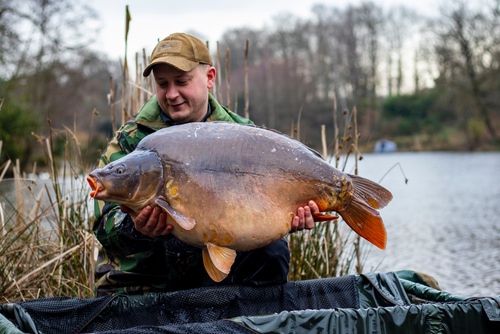
The largest carp caught on a rod and reel in New Hampshire was 35 pounds!
©malgosia janicka/Shutterstock.com
In New Hampshire, on May 16, 2015, Donald St. Lawrence caught another super impressive carp in the Merrimack River, Manchester. This big fish weighed 35 pounds 13.12 ounces and was 37 inches long! It wasn’t just a testament to how big carp can grow here, but it also showcased the passion and awesome skills of the local fishermen. After all, catching such a huge fish is no small feat, and it really showcases the angler’s talent.
5. Burbot — 12 Pounds, 35.0 Inches

Burbot are also called freshwater cusks.
©Rostislav Stefanek/Shutterstock.com
The burbot, also called the freshwater cusk, is a freshwater species that is found in the cold waters of the Northern USA and Canada. It has a sleek, long body, a small head, and a wide mouth. Adult cusks usually grow to be 12 to 20 inches and can weigh between 4 to 8 pounds on average. That said, they have been known to grow larger. They have a gray or brown coloration with a lighter belly. Interestingly, they love hanging around deep, rocky places, around 60 and even up to 600 feet deep in some cases. During winter, they swim up to shallower spots. They munch on small crustaceans and fish,
On January 13, 2022, Ryan Scott Ashley caught the largest burbot fish in New Hampshire’s Lake Winnipesaukee in Moultonborough. This fish weighed 12 pounds and was 35 inches long!
6. Rainbow Trout — 15 Pounds, 35.5 Inches

Frequently growing to more than 2 feet long, rainbow trout are a popular trophy fish.
©Henrik A. Jonsson/Shutterstock.com
Rainbow trout are a popular game fish native to the cold-water tributaries of the Pacific Ocean in North America. They have a sleek body and are silver or olive green in color, with a red stripe on the side and black spots on their back and fins. These fish usually grow 20 to 30 inches long and weigh between 2 to 16 pounds, but some can get even bigger. Their diet? Mainly insects, crustaceans, and smaller fish.
Lance King caught the biggest rainbow trout in New Hampshire. This happened way back on September 16, 1996, at the Pemigewasset River in Bristol. This catch weighed 15 pounds 7.2 ounces and was 35.5 inches long! Now, that’s a big trout! So, if you love trout fishing, this state is definitely a place to consider.
7. Brown Trout — 16 Pounds, 32.5 Inches
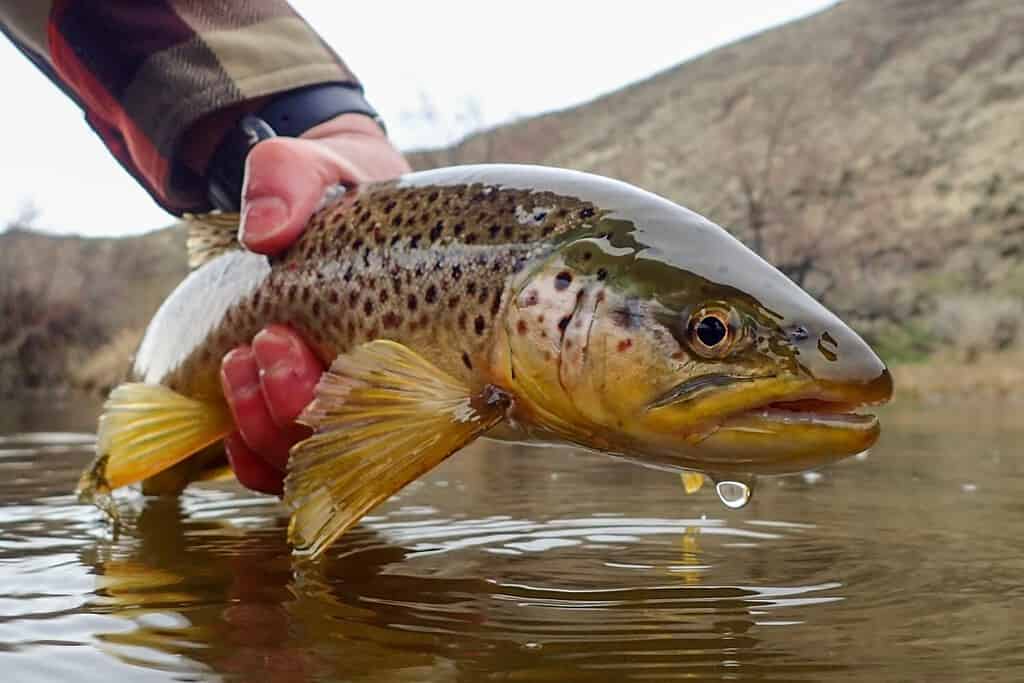
Originally hailing from Europe, brown trout are now a common fish species in New Hampshire.
©CSNafzger/Shutterstock.com
Brown trout are interesting fish originally from Europe but are now found all over the world. Their light brown or greenish bodies are beautifully decorated with black and reddish-orange spots. These fish usually grow to 15 to 22 inches, but they can get bigger. They live in different freshwater spots like rivers and lakes and eat a mix of things — mainly insects, tiny water creatures, and smaller fish.
On July 4, 1975, Ken Reed, Jr. caught the biggest brown trout in New Hampshire. It was in the Connecticut River in Pittsburg, weighing a hefty 16 pounds 6 ounces and measuring 32.5 inches.
8. Channel Catfish — 15 Pounds, 31.9 Inches

Common bottom feeders in freshwater lakes and rivers, channel
catfish
can grow to more than 10 pounds.
©Alauddin Abbasi/Shutterstock.com
Channel catfish are a common North American freshwater fish with a sleek body and a broad, flat head. They have no scales, with thick gray or silvery-blue skin. They usually grow to be about 20 to 30 inches long, and while they often weigh between 2 to 10 pounds, some can be much heavier. These fish love slow-moving fresh waters like rivers and streams, and they mostly snack on small fish and bugs.
Scott Alexander, Jr. caught the biggest channel catfish in New Hampshire on September 27, 2022. It happened in the Connecticut River in Hinsdale, and this big fish weighed 15 pounds 12.8 ounces and measured 31.9 inches! This catch showcases the favorable conditions of New Hampshire’s waters for sustaining and growing sizable catfish populations, which is a testament to the state’s diverse and healthy aquatic ecosystems.
9. Landlocked Salmon — 18 Pounds, 36.0/34.5 Inches

Atlantic and landlocked salmon are the same species, but landlocked salmon only live in freshwater.
©takas0325/Shutterstock.com
Landlocked salmon are the freshwater siblings to the Atlantic Salmon. They have this shiny blue-green skin with a unique X-shaped pattern on their back. Typically, they grow to 12 to 20 inches, but they can certainly get bigger. They thrive in cold, clear waters, making New Hampshire the perfect environment.
New Hampshire has two record-breaking catches for this fish! Mr. P.H. Killelea caught one on August 30, 1914, at Pleasant Lake in New London. This fish weighed 18 pounds 8 ounces and was a whopping 36 inches long. Interestingly, Mrs. Letty M. Clark caught another 18-pounder salmon in 1942 that was 34.5 inches long in the same lake! These catches reflect the rich angling history and the conducive environment in New Hampshire for landlocked salmon, a species cherished by anglers.
10. Largemouth Bass — 10 Pounds, 25.8 Inches

Easy to recognize by their giant mouths, largemouth bass are a fish that can grow to large sizes in New Hampshire.
©Maclane Parker/Shutterstock.com
Largemouth bass are popular game fish with a greenish to olive coloration and, as their name suggests, an enormous mouth. Their body is laterally compressed with a nearly divided dorsal fin. They’re not always super-sized. They are usually around 16 inches long and weigh between 1 to 3.46 pounds. These fish love quiet, clear waters with lots of plants, munching on a diet like small fish, crustaceans, and insects.
In May 1967, G. Bullpitt caught the biggest largemouth bass in New Hampshire at Lake Potanipo in Brookline. This fish weighed 10 pounds 8 ounces and was 25.8 inches long!
11. Brook Trout — 9 Pounds, 25.5 Inches
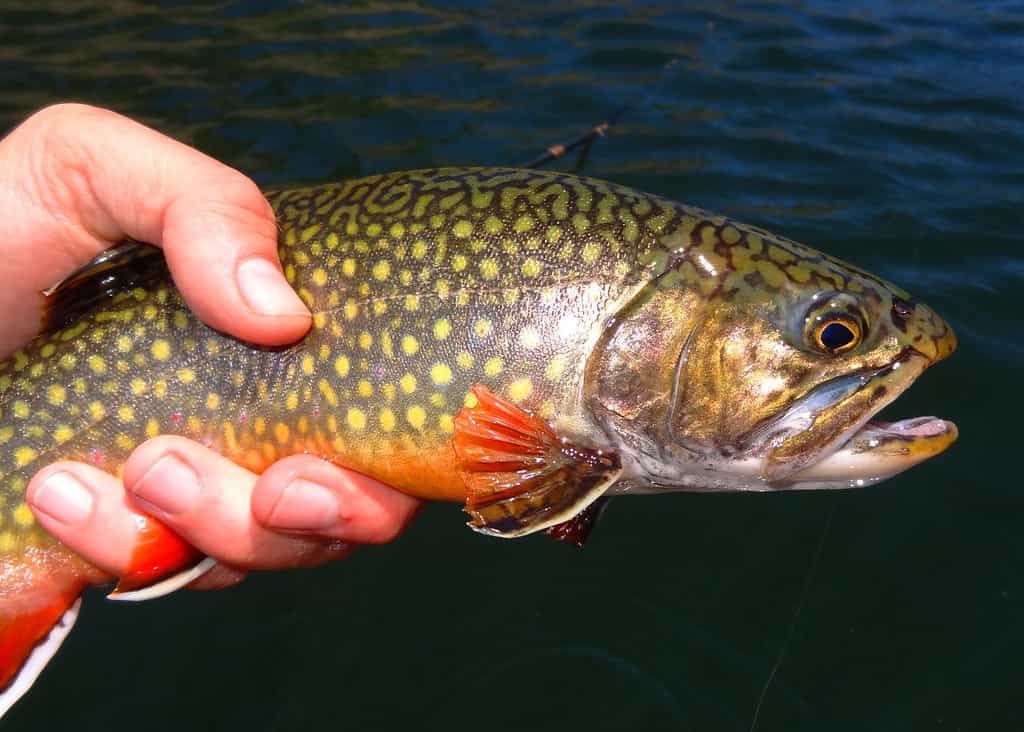
A symbol of clean water, brook trout thrive in New Hampshire.
©Matt Jeppson/Shutterstock.com
Brook trout are freshwater fish from North America that are part of the salmon family. They have this dark green or brown look, but what’s really eye-catching is their light-marbled patterns and red bellies. These fish aren’t usually huge, usually clocking in between 6 to 24 inches long and weighing 1 to 15 pounds, but some can grow impressively big. They love cool, clear waters with lots of rocks and feast mainly on insects, crustaceans, and small fish, making New Hampshire’s lakes an optimal paradise.
The biggest brook trout in New Hampshire was caught by A. Val Woodruff on May 8, 1911, in Pleasant Lake, New London. This fish weighed 9 pounds and measured 25.5 inches!
12. Bowfin — 8 Pounds, 28.0 Inches
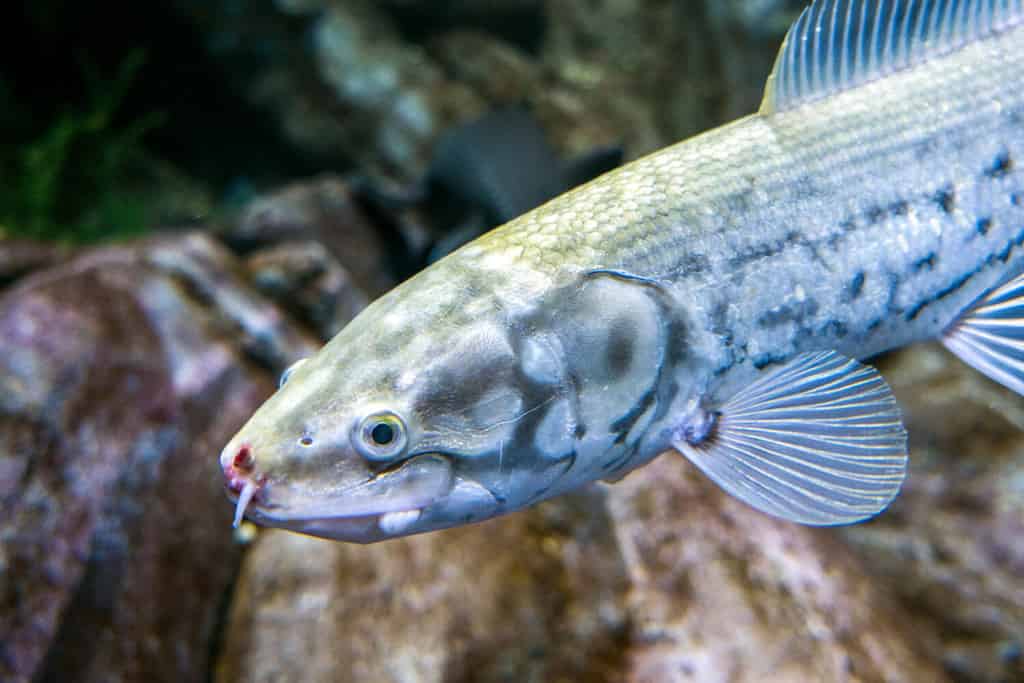
An extremely unique and recognizable freshwater fish is the bowfin.
©Miroslav Halama/Shutterstock.com
Bowfin are an interesting North American freshwater fish with long bodies, large mouths, and a continuous fin running down their backs. Their dark olive color is perfect for hiding in swampy areas. Usually, they’re about 18 to 30 inches long and weigh anywhere from 1 to 21 pounds. They prefer slow waters and munch mainly on other fish, crustaceans, and occasionally insects.
The biggest Bowfin fish in New Hampshire was caught by Kenneth L’Abbe on August 24, 1994, at Wilson Pond, Swanzey. This fish weighed 8 pounds 13 ounces and measured a remarkable 28 inches!
13. Chain Pickerel — 8 Pounds, 26.0 Inches

As common freshwater fish on the East Coast, chain pickerels are common catches in New Hampshire.
©RLS Photo/Shutterstock.com
Chain pickerel are freshwater fish from North America that look similar to pike. Their long bodies have a neat chain-like pattern on the sides, hence the name. Most chain pickerel are about 12 to 24 inches long and weigh up to 4 pounds. They inhabit slow-moving waters with lots of plants, munching on small fish, frogs, worms, or insects.
Carroll R. Akeley caught the biggest chain pickerel in New Hampshire on April 24, 1966. It was a whopping 8 pounds and 26 inches, caught at Plummer Lake in Sanbornton!
14. Lake Whitefish — 5 Pounds, 21.75 Inches
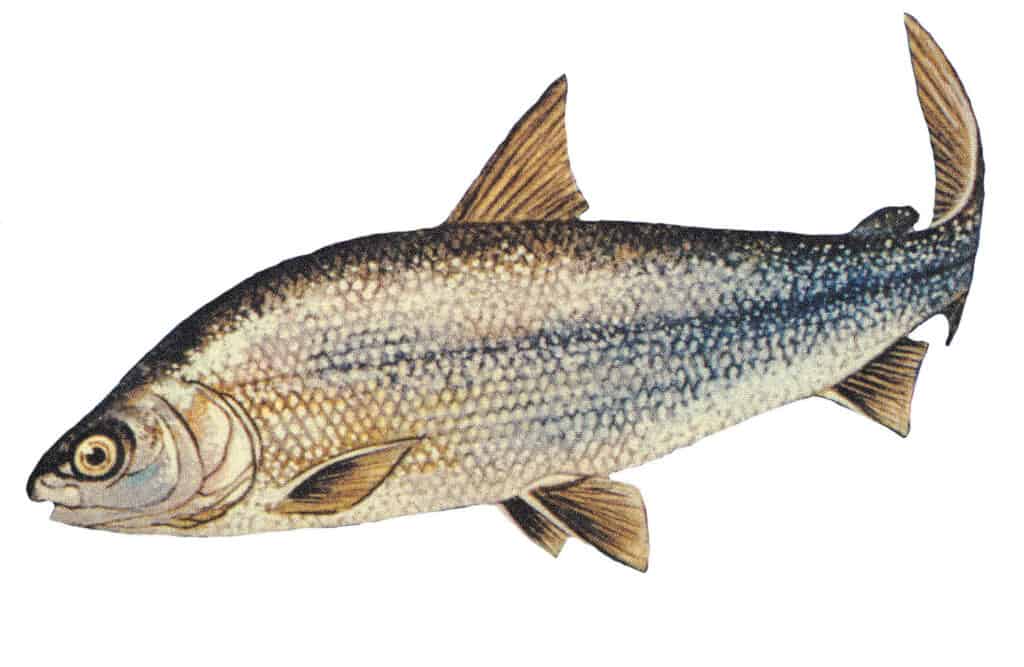
Another large fish caught in New Hampshire is the lake whitefish.
©NOAA Great Lakes Environmental Research Laboratory / flickr – License
Lake whitefish are slender fish found in northern parts of North America. They have silvery slender bodies with a small head and a slightly humped back. These fish are usually 14 to 25 inches long. Although they’re lightweight, generally between 1 to 6 pounds, they’re strong swimmers. You can generally catch whitefish in cold, deep lakes with sandy or gravelly bottoms.
Paul E. Littlefield caught the heaviest lake whitefish in New Hampshire. On August 23, 1974, he reeled in a fish that weighed 5 pounds 1 ounce, which measured a decent 21.75 inches.
15. Fallfish — 3 Pounds, 20.75 Inches
Fallfish are minnow species, the largest of their kind in the northeast US. Their silver-gray bodies can reach between 5-18 inches and have a slight hump and a distinct, scaleless head. Usually found in clean rivers with gravel bottoms, they eat food like insects and tiny fish.
John Conti caught an unusually big fallfish in New Hampshire. On July 12, 1991, at Lake Winnipesaukee in Gilford, he reeled in fish weighing 3 pounds 8.96 ounces, measuring a whopping 20.75 inches!
16. Black Crappie — 2 Pounds, 17.0 Inches
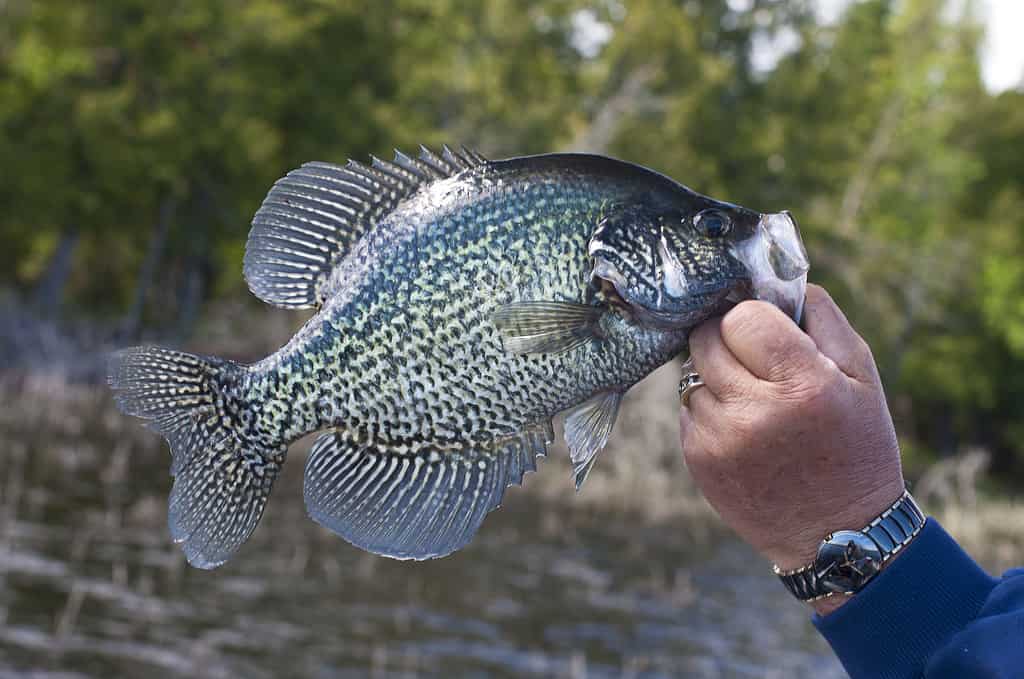
The scientific name for the black crappie is Pomoxis nigromaculatus.
©SteveOehlenschlager/iStock / Getty Images Plus via Getty Images
Black crappie is a popular freshwater game fish you will find all across North America. These silver-gray fish are spotted with black patterns and usually grow between 6 to 11 inches. Additionally, they typically weigh up to 3 to 4 pounds. These fish love calm waters like lakes and slow rivers. They mainly eat small insects and tiny fish.
On May 3, 2016, Brian O’Day caught the biggest black crappie in New Hampshire, weighing 2 pounds 15.84 ounces and stretching 17 inches!
17. Brown Bullhead — 3 Pounds, 17.95 Inches

Large bottom feeders in the catfish family, bullheads can grow to more than a foot long!
©Brenda Miroslav/Shutterstock.com
Brown bullheads are a species of catfish found in North America. They have a stout body — dark brown to greenish in color — with a rounded tail fin and a lighter belly. Usually, they’re about 8 to 13 inches long, but sometimes they grow bigger. They love slow-moving waters like lakes and rivers with soft, muddy bottoms. Bullheads have an extremely diverse diet. They will feed on anything from insects, small fish, baby bullheads, and even plants.
Donald Robbins caught the biggest brown bullhead in New Hampshire on August 6, 2005. It weighed 3 pounds 4.8 ounces and was 17.95 inches long!
18. Rock Bass — 1 Pound, 13.5 Inches

Generally a relatively small species, rock bass can occasionally grow to more than one pound.
©Steve Brigman/Shutterstock.com
Rock bass are freshwater fish found mainly in the eastern U.S. and Canada. They have a dark olive to brownish, compressed body with striking red eyes and 5-7 spines in the anal fin. While they’re usually 5 to 10 inches long and weigh under a pound, larger individuals are possible. They inhabit warm, rocky parts of lakes and streams. Anglers will typically find them near places like logs or plants. What do they eat? Like many fish on this list rock bass consume small fish, insects, and crustaceans.
Linc Chamberland caught the biggest rock bass ever caught New Hampshire. It was on September 18, 1982, and the fish weighed 1 pound 8 ounces and was 13.5 inches long! This catch really shows how awesome New Hampshire’s waters are for fishing. Whether you’re an expert angler or just starting out, it’s a great place to try your luck.
Summary of the Largest Fish Ever Caught in New Hampshire
| Number | Fish | Weight | Length | Location | Date | Angler |
|---|---|---|---|---|---|---|
| 1 | Northern Pike | 26 lbs. 9.44 oz. | 44.5″ | Moore Reservoir, Dalton | 2/16/2013 | Kevin Phelps |
| 2 | Lake Trout | 37 lbs. 10.4 oz. | 42.125″ | Big Diamond Pond, Stewartstown | 2/25/2020 | Thomas Knight |
| 3 | Carp (Bow Harvested) | 41 lbs. 0.04 oz. | 40.5″ | Connecticut River, Hinsdale | 6/2/2013 | Kevin Martin |
| 4 | Carp | 35 lbs. 13.12 oz. | 37.0″ | Merrimack River, Manchester | 5/16/2015 | Donald St. Lawrence |
| 5 | Cusk | 12 lbs. | 35.0″ | Lake Winnipesaukee, Moultonborough | 1/13/2022 | Ryan Scott Ashley |
| 6 | Rainbow Trout | 15 lbs. 7.2 oz. | 35.5″ | Pemigewasset River, Bristol | 9/16/1996 | Lance King |
| 7 | Brown Trout | 16 lbs. 6 oz. | 32.5″ | Connecticut River, Pittsburg | 7/4/1975 | Ken Reed, Jr. |
| 8 | Channel Catfish | 15 lbs. 12.8 oz. | 31.9″ | Connecticut River, Hinsdale | 9/27/2022 | Scott Alexander, Jr. |
| 9 | Landlocked Salmon | 18 lbs. 8 oz. | 36.0″/34.5″ | Pleasant Lake, New London | 8/30/1914 / 8/31/1942 | Mr. P.H. Killelea / Mrs. Letty M. Clark |
| 10 | Largemouth Bass | 10 lbs. 8 oz. | 25.8″ | Lake Potanipo, Brookline | 5/1967 | G. Bullpitt |
| 11 | Brook Trout | 9 lbs. | 25.5″ | Pleasant Lake, New London | 5/8/1911 | A. Val Woodruff |
| 12 | Bowfin | 8 lbs. 13 oz. | 28.0″ | Wilson Pond, Swanzey | 8/24/1994 | Kenneth L’Abbe |
| 13 | Chain Pickerel | 8 lbs. | 26.0″ | Plummer Lake, Sanbornton | 4/24/1966 | Carroll R. Akeley |
| 14 | Lake Whitefish | 5 lbs. 1 oz. | 21.75″ | Lake Winnipesaukee, Alton | 8/23/1974 | Paul E. Littlefield |
| 15 | Fallfish | 3 lbs. 8.96 oz. | 20.75″ | Lake Winnipesaukee, Gilford | 7/12/1991 | John Conti |
| 16 | Black Crappie | 2 lbs. 15.84 oz. | 17.0″ | Great East Lake, Wakefield | 5/3/2016 | Brian O’Day |
| 17 | Brown Bullhead | 3 lbs. 4.8 oz. | 17.95″ | Merrimack River, Merrimack | 8/06/2005 | Donald Robbins |
| 18 | Rock Bass | 1 lb. 8 oz. | 13.5″ | Island Pond, Stoddard | 9/18/1982 | Linc Chamberland |
The photo featured at the top of this post is © Maclane Parker/Shutterstock.com
Thank you for reading! Have some feedback for us? Contact the AZ Animals editorial team.






